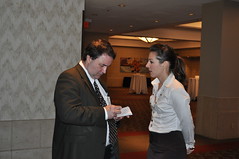Sometimes the ability to write good dialogue becomes a crutch. We feel like we should show all possible dialogue—but it’s just not the case.
Sometimes, the story—the pacing, the conflict, and most of all the reader—is better served by summarizing dialogue. This seems to be the case in stories where one character is telling another about actions the reader has already seen. Most of the time (unless we’re going for a Rashomon effect), the reader stands to gain nothing from rehashing an event that the other character needs to hear about.
It’s really not a sin to write something along the lines of “She related the whole story of X” or “He caught her up on the status of the battle.” If the POV character is the one telling the story, the reader probably needs very little cues. If the current POV character is listening to the story (i.e. we saw the scene from another character’s POV before this), we might get into some more detail with the POV character’s reactions and interpretations.
 This might also work well if the readers haven’t seen the event in question—but they’ve already heard about it. For example, in a mystery, a detective or PI might interview half a dozen witnesses who all saw essentially the same thing. We definitely don’t need to see every single full conversation—the pertinent parts (like the details only one person saw, or the red herrings, or whatever) are all we need.
This might also work well if the readers haven’t seen the event in question—but they’ve already heard about it. For example, in a mystery, a detective or PI might interview half a dozen witnesses who all saw essentially the same thing. We definitely don’t need to see every single full conversation—the pertinent parts (like the details only one person saw, or the red herrings, or whatever) are all we need.
On the other hand, if the readers haven’t already seen the events being described, it might be better—and often less confusing and simpler—to write out the character’s full run down. If it turns into a speech, break it up into a conversation, or at least add reactions from the POV character. (I can’t think of a time the POV character would give one of these speeches. Maybe for backstory? Ack.)
Now for the third hand. I haven’t decided if I like this technique, but every so often, I see something like this:
Billy and I moved on to the next painting.
“That’s the ugliest thing I’ve ever seen.” He curled his lip in disgust.
Well, I thought he was the ugliest thing I’d ever seen, and told him so. “And also, you stink. But most of all, your taste in art stinks.”
Now, this would never work for me if the second paragraph said Well, I thought he was the ugliest thing I’d ever seen. “You’re the ugliest thing I’ve ever seen. And also, you stink. But most of all, your taste in art stinks.”
But for me the jury’s still out on the first version. I’m a dialogue lover, so I would tend toward just putting it in dialogue, and cutting the “Well, I thought . . .” part—I mean, if you say it, the reader’s going to figure out that they’re thinking it, right?
What do you think? How does that example of indirect dialogue work for you? How else might we use non-dialogue for dialogue?
Photo by the Michigan Municipal League



